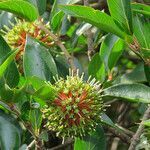It can be a shrub or climber or small tree. It is evergreen. The stem can be 20 cm across. The leaves are dark green and shiny. They are 1.3-3.8 cm long and egg shaped but often broadest below the middle. The have a blunt point with a long jutting tip. The edges of the leaves are often rolled inwards. The flowers are small and red or greenish-white. They form tubes. They are 2.5 cm across. They occur at the ends of twigs. The fruit are made up of many small fruitlets packed into a round head. They turn pink or red when ripe. They are edible.
Leaves 1–5.5(8) × 0.7–3 cm, oblong, ovate-oblong or elliptic-oblong, acute to acuminate at the apex, acute to truncate at the base, dark green and shiny, glabrous or nearly so; domatia usually present; petioles 1–7 mm long, margined or ± winged, usually puberulous; stipule bases 1.5 mm long, ± rounded-triangular, the appendage 2 mm long, linear-oblong, at length the apex or whole stipule deciduous.
Small tree or shrub, scrambler or climber, up to 5 m high. Leaves ovate to ovate-elliptic, acute to acuminate, glabrous. Inflorescence a loose globular head, terminal. Fruit heads becoming succulent. Flowers with white or greenish tube, lobes maroon; calyx red or pink.
Corolla white, reddish or greenish-white; tube 6–7 mm long, widened at throat, glabrous outside, densely pubescent inside; lobes 0.5–1 mm long, triangular, ovate or oblong, pubescent inside.
Infructescences 2–2.5 cm in diameter, consisting of tightly packed but separate pink, red or white succulent fruits, each 2–3 mm long, oblong; calyx lobes persistent and folding inwards.
Semiscandent or climbing evergreen shrub or small tree 2.5–10 m tall or long, with trailing branches; young shoots puberulous, older grey-brown, ridged when dry, lenticellate.
Flower heads up to 3, or more usually solitary, 2–2.5 cm wide including corollas; peduncle 2–2.5 cm long, puberulous.
Calyx limb-tube 2–3 mm long, puberulous; lobes 0.5–1 mm long, elliptic, pubescent.
Style exserted 5–7 mm including the narrowly clavate pollen presenter.
Black glands absent from corolla, calyx and stipules.
Pyrene brown, 2.5 mm long.


